Chapter 3: Healthcare Careers
Learning Objectives
- Evaluate various healthcare careers based on job qualifications and industry outlooks.
- Assess the skills required to be a competent healthcare professional.
- Understand the different career paths available in healthcare.
Introduction
Every day, around the clock, people who work in the healthcare industry provide care for millions of people, from newborns to the very ill. In fact, the healthcare industry is one of the largest providers of jobs in the United States. Many health jobs are in hospitals. Others are in nursing homes, doctors’ offices, dentists’ offices, outpatient clinics, and laboratories. In this chapter, we will explore past, current, and future healthcare employment trends, review the skills necessary to be a successful health professional, and examine the many different types of occupations in the health field.
Healthcare Careers BACKground
Healthcare Employment: Past and Future Outlook
Healthcare jobs make up a significant portion of the U.S. labor force, with a wide range of positions available to suit a variety of skills and interests. Between 2012 and 2022, total employment in the U.S. (excluding farm workers) grew by 15%, or 19.7 million jobs. In comparison, the healthcare sector grew by 16% (4.2 million jobs) (Figure 3.1) (U.S. Bureau of Labor Statistics, n.d.).
However, at different times between 2020 and 2022, many areas of the U.S. faced healthcare workforce shortages tied to COVID-19 surges. COVID-19 put increased demands on the healthcare workforce in terms of messaging, immunizations, testing, and inpatient/outpatient care while often limiting the supply of healthcare workers able to respond. While some healthcare workers were stretched in the early phase of the pandemic and in subsequent surges trying to address the needs of COVID-19 patients, other healthcare workers not involved in the response were furloughed or had their hours reduced, as facilities temporarily closed or limited elective procedures to minimize revenue loss. The pandemic also exacerbated existing workforce shortages faced by home care agencies. Some workers left the workforce due to fear of contracting the virus or infecting family members or clients; others were unable to maintain sufficient hours because clients refused visits because they were fearful of allowing anyone into their homes and because fewer clients were being referred to home health when many states restricted elective surgeries.
Significant actions by federal, state, and local authorities as well as by health systems and individual providers have attempted to address these disruptions. Some actions were new efforts addressing specific costs associated with testing for, immunization against, and treatment of COVID-19. Others sought to address workforce capacity shortages, such as increasing Medicare funding to support physician training. However, these pandemic-related disruptions and workforce shortages took place within the context of significant pre-pandemic shortages in some geographic areas, many of which were exacerbated by the uneven and extended duration of the pandemic, as well as pre-existing concerns about high levels of burnout and mental health challenges for many healthcare workers.
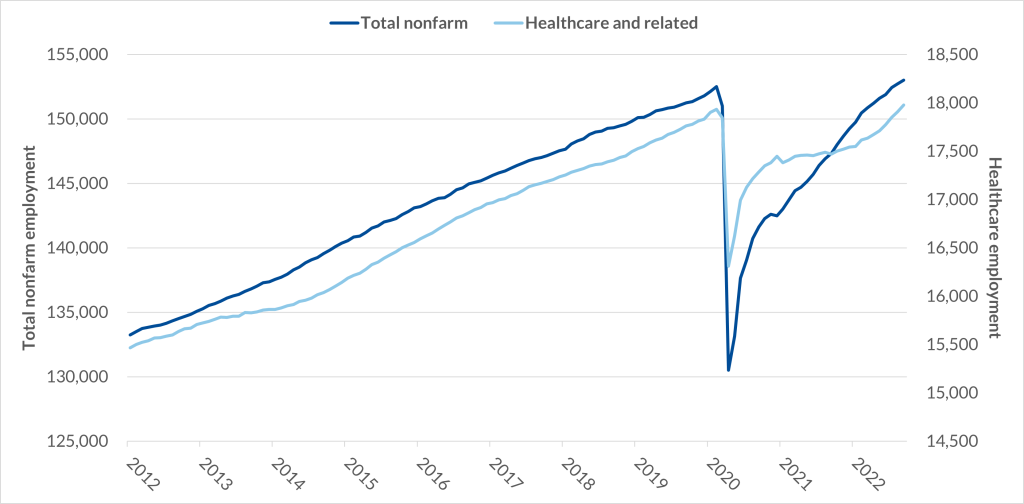
Nonetheless, the healthcare sector is, and is expected to remain, a significant piece of the U.S. economy. As of September 2022, healthcare and healthcare-related occupations comprise approximately 12% (18 million) of jobs in the U.S.; in other words, more than one in 10 employed Americans work in healthcare or healthcare-related jobs. Most work in hospitals (37%) and offices of health practitioners (28%), with nursing and residential care facilities (17%), outpatient, laboratory, and other ambulatory services (9%), and home healthcare services (9%) accounting for the remaining jobs (U.S. Bureau of Labor Statistics, n.d.).
Overall employment in healthcare occupations is projected to grow 13% from 2021 to 2031, much faster than the average for all occupations; this increase is expected to result in about 2 million new jobs over the decade. In addition to new jobs from growth, opportunities arise from the need to replace workers who leave their occupations permanently. About 1.9 million openings each year, on average, are projected to come from growth and replacement needs.
Core Skills in Healthcare
To be successful in any field, it is expected that workers within that industry possess certain competencies. A competency is the capability to apply or use a set of related knowledge, skills, and abilities required to successfully perform “critical work functions” or tasks in a defined work setting. Not to be confused with competence, a competency describes a behavior but does not attempt to describe a level of performance. A competency model is a collection of competencies that together define successful performance in a particular work setting.
There are many career paths in healthcare, each with its own set of requisite knowledge, skills, and abilities. However, common competencies apply to all occupations within the field. Developed by the Employment and Training Administration and Health Professionals Network, the Fundamentals of Health Care Competency Model describes what a worker needs to know and be able to do in order to be successful in the field.
Select Competencies from the Fundamentals of Health Care Competency Model
- Interpersonal Skills
- Maintain open lines of communication with others.
- Integrity
- Behaving ethically.
- Accept responsibility for one’s decisions and actions and for those of one’s group, team, or department.
- Professionalism
- Deal calmly and effectively with stressful or difficult situations.
- Accept criticism tactfully and attempt to learn from it.
- Dress appropriately for occupational and worksite requirements.
- Lifelong Learning
- Learn and accept help from supervisors and co-workers.
- Take charge of personal career development by identifying occupational interests, strengths, options, and opportunities.
- Teamwork
- Develop constructive and cooperative working relationships with others.
- Work as part of a team, contributing to the group’s effort to achieve goals.
- Problem Solving and Decision-Making
- Make difficult decisions even in highly ambiguous or ill-defined situations.
- Business Fundamentals
- Recognize one’s role in the functioning of the organization and understand the potential impact one’s own performance can have on the success of the organization.
- Health and Safety
- Take actions to ensure the safety of self and others, in accordance with established personal and job site safety practices.
For the full list, see “Fundamentals of Health Care Competency Model” from the Competency Model Clearinghouse.
Choosing a career
To understand what type of work suits you and to be able to convey that to others to get hired, you must become an expert in knowing who you are. Gaining self-knowledge is a lifelong process, and college is the perfect time to gain and adapt this fundamental information. The following are some of the types of information that you should have about yourself:
- Interests: Things that you like and want to know more about. These often take the form of ideas, information, knowledge, and topics.
- Skills/Aptitudes: Things that you either do well or can do well. These can be natural or learned and are usually skills—things we can demonstrate in some way.
- Values: Things that you believe in. Frequently, these are conditions and principles.
- Personality: Things that combine to make you distinctive. Often, this shows in the way you present yourself to the world. Aspects of personality are customarily described as qualities, features, thoughts, and behaviors.

Other Factors
When considering your desired career path, also think about the factors that will influence your success as a student and future healthcare professional. Ask yourself the following:
- How much time must I invest before I actually start making money in this career? Will I need to spend additional time in school? If so, can I afford to wait?
- Will this career provide me with the kind of income I need in the short term and the security I’ll want in the longer term? What investment will I need to make to be successful in this field (education, tools, franchise fees, et cetera.)?
- How will this career affect my personal and family life? Do friends and family members who know me well feel strongly (for or against) about this career choice? How important is their input?
- What physical and social factors do I desire in my career? For example, does this career necessitate working conditions that do not align with my needs or abilities? Will I be exposed to hazardous conditions? If so, am I comfortable with that possibility? Will this career require too much or too little interaction with other people for my preferences? Will the work be highly routine or challenging?
Additionally, know whether you must obtain credentialing beyond your college education before you can begin working, as this may add additional time and cost to your career plan. Licenses and certifications show that a person has the specific knowledge or skill needed to do a job. Although the two terms may be used interchangeably, a license and certification refer to separate credentials:
- License
- Awarded by a governmental licensing agency
- Gives legal authority to work in an occupation
- Requires meeting predetermined criteria, such as having a degree or passing a state-administered exam
- Certification
- Awarded by a professional organization or other nongovernmental body
- Is not legally required in order to work in an occupation
- Requires demonstrating competency to do a specific job, often through an examination process
Typically, you earn these credentials after you’ve completed your education. Sometimes, you become licensed or certified after you’ve gained practical experience, such as through an internship, residency, or time on the job. Earning a license or certification involves meeting standards, which often includes passing an exam. An employer may require either credential.
These terms should not be confused with accreditation, which is the recognition from an accrediting agency that an institution maintains a certain level of educational standards requisite for its graduates to gain admission to other reputable institutions of higher learning or to achieve credentials for professional practice.
Choosing A Career: Self-Reflection Activity
Occupational Profiles
The following represent the five groups of occupations associated with the healthcare industry in the U.S.
Biotechnology Research and Development Occupations
 |
 |
|
| Occupation | Bioengineers and Biomedical Engineers | Medical Scientists |
| Description | Combine engineering principles with sciences to design and create equipment, devices, computer systems, and software. | Conduct research aimed at improving overall human health. Often use clinical trials and other investigative methods to reach their findings. |
| Entry-Level Education | Bachelor’s | Doctorate or medical degree |
| Credentialing Requirements | None | Licensure required for some roles |
| Median Wage ($) | 97,410 | 95,310 |
| Job Outlook, (2021-31) | 10% increase | 17% increase |
| Skills | Analytical skills Communication skills Creativity Math skills Problem-solving skills |
Communication skills Critical-thinking skills Data-analysis skills Decision-making skills Observation skills |
Diagnostic Services Occupations
 |
 |
 |
|
| Occupation | Cardiovascular Technologists and Technicians | Clinical Laboratory Technicians | Clinical Laboratory Technologists |
| Description | Create images and conduct tests involving the heart and lungs. | Collect samples and perform tests to analyze body fluids, tissue, and other substances. | Perform more complex tests and laboratory procedures than technicians. |
| Entry-Level Education | Associate’s | Associate’s | Bachelor’s |
| Credentialing Requirements | Varies by state | Varies by state | Varies by state |
| Median Wage ($) | 60,570 | 57,800 | 57,800 |
| Job Outlook, (2021-31) | 5% increase | 7% increase | 7% increase |
| Skills | Communication skills Detail-oriented Hand-eye coordination Physical stamina Technical skills |
Ability to use technology Detail-oriented Dexterity Physical stamina |
Ability to use technology Detail-oriented Dexterity Physical stamina |
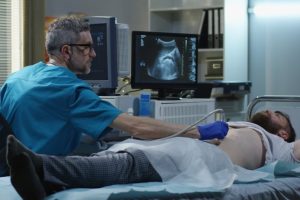 |
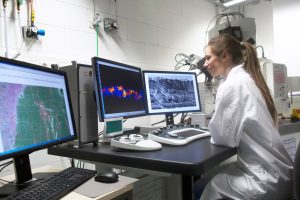 |
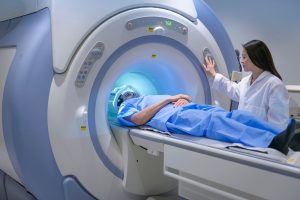 |
|
| Occupation | Diagnostic Medical Sonographers | Epidemiologists | MRI Technologists |
| Description | Specialize in creating images, known as sonograms or ultrasounds, that depict the body’s organs and tissues. | Public health workers who investigate patterns and causes of disease and injury. | Operate magnetic resonance imaging (MRI) scanners to create diagnostic images. |
| Entry-Level Education | Associate’s | Master’s | Associate’s |
| Credentialing Requirements | Varies by state | None | Licensure required in a few states |
| Median Wage ($) | 77,740 | 78,830 | 77,360 |
| Job Outlook, (2021-31) | 15% increase | 26% increase | 7% increase |
| Skills | Communication skills Detail-oriented Hand-eye coordination Physical stamina Technical skills |
Communication skills Critical-thinking skills Detail-oriented Leadership skills Math and statistical skills |
Detail-oriented Interpersonal skills Math skills Physical stamina Technical skills |
 |
 |
||
| Occupation | Nuclear Medicine Technologists | Radiologic Technologists | |
| Description | Prepare radioactive drugs and administer them to patients for imaging or treatment. | Perform x-rays and other diagnostic imaging examinations on patients. | |
| Entry-Level Education | Associate’s | Associate’s | |
| Credentialing Requirements | Varies by state | Licensure or certification required in most states | |
| Median Wage ($) | 78,760 | 61,370 | |
| Job Outlook, (2021-31) | 2% increase | 6% increase | |
| Skills | Ability to use technology Analytical skills Compassion Detail-oriented Interpersonal skills Physical stamina |
Detail-oriented Interpersonal skills Math skills Physical stamina Technical skills |
Health Informatics Occupations
 |
 |
 |
|
| Occupation | Health Information Technologists and Medical Registrars | Medical Records Specialists | Medical Transcriptionists |
| Description | Advise organizations on computerized healthcare systems and analyze clinical data. | Compile, process, and maintain patient files. | Use electronic devices to convert voice recordings from physicians and other healthcare workers into formal reports. |
| Entry-Level Education | Associate’s | Postsecondary nondegree award | Postsecondary nondegree award |
| Credentialing Requirements | None; certification may be preferred by employers | None; certification may be preferred by employers | None; certification available |
| Median Wage ($) | 55,560 | 46,660 | 30,100 |
| Job Outlook, (2021-31) | 17% increase | 7% increase | 7% decrease |
| Skills | Analytical skills Detail-oriented Integrity Interpersonal skills Problem-solving skills |
Analytical skills Detail-oriented Integrity Interpersonal skills |
Computer skills Critical-thinking skills Listening skills Time-management Writing skills |
Support Services Occupations
 |
 |
 |
|
| Occupation | Medical and Health Services Managers and Administrators | Orderlies | Pharmacy Technicians |
| Description | Plan, direct, and coordinate medical and health services. They may manage an entire facility, a specific clinical area or department, or a medical practice for a group of physicians. | Transport patients and clean treatment areas. | Help pharmacists dispense prescription medication to customers or health professionals. |
| Entry-Level Education | Bachelor’s | High school diploma or equivalent | High school diploma or equivalent |
| Credentialing Requirements | Varies by state | None | Varies by state |
| Median Wage ($) | 101,340 | 29,990 | 36,740 |
| Job Outlook, (2021-31) | 28% increase | 5% increase | 5% increase |
| Skills | Analytical skills Communication skills Detail-oriented Interpersonal skills Leadership skills Technical skills |
Communication skills Compassion Patience Physical stamina |
Customer-service skills Detail-oriented Listening skills Math skills Organizational skills |
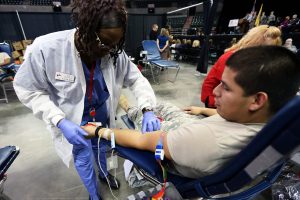 |
|||
| Occupation | Phlebotomists | ||
| Description | Draw blood for purposes such as tests, research, or donations. | ||
| Entry-Level Education | Postsecondary nondegree award | ||
| Credentialing Requirements | Varies by state | ||
| Median Wage ($) | 37,380 | ||
| Job Outlook, (2021-31) | 10% increase | ||
| Skills | Communication skills Compassion Detail-oriented Dexterity Interpersonal skills Physical stamina |
Therapeutic Services Occupations
 |
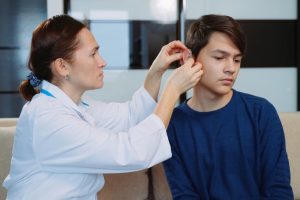 |
 |
|
| Occupation | Athletic Trainers | Audiologists | Behavior Analysts* |
| Description | Specialize in preventing, diagnosing, and treating muscle and bone injuries and illnesses. Not to be confused with fitness trainers and instructors. | Diagnose, manage, and treat patients who have hearing, balance, or related problems. | Observe and analyze the behavior of individuals in order to develop treatment plans that improve skill repertoires, safety, and quality of life. Includes Board Certified Assistant Behavior Analysts (BCaBAs) and Board Certified Behavior Analysts (BCBAs). |
| Entry-Level Education | Master’s | Doctorate or professional degree | Bachelor's (BCaBA); Master's (BCBA) |
| Credentialing Requirements | Licensure or certification required in most states | Licensure required in all states | Certification required in all states; Licensure required in some states |
| Median Wage ($) | 48,420 | 78,950 | 50,000 (BcaBA), 90,130 (BCBA) |
| Job Outlook, (2021-31) | 17% increase | 10% increase | 10% increase |
| Skills | Compassion Decision-making skills Detail-oriented Interpersonal skills |
Communication skills Compassion Critical-thinking skills Interpersonal skills Patience Problem-solving skills |
Active listening Complex problem solving Critical thinking Instructing Reading comprehension Social perspectives |
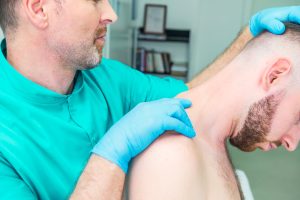 |
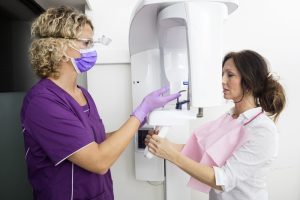 |
 |
|
| Occupation | Chiropractors | Dental Assistants | Dental Hygienists |
| Description | Evaluate and treat patients’ neuromusculoskeletal system using spinal adjustments and manipulation, as well as other clinical interventions. | Provide patient care, take x-rays, keep records, and schedule appointments. | Examine patients for signs of oral diseases and provide preventive care. |
| Entry-Level Education | Doctorate or professional degree | Postsecondary nondegree award | Associate’s |
| Credentialing Requirements | Licensure required in all states | Varies by state | Licensure required in all states |
| Median Wage ($) | 75,000 | 38,660 | 77,810 |
| Job Outlook, (2021-31) | 10% increase | 8% increase | 9% increase |
| Skills | Communication skills Decision-making skills Detail-oriented Dexterity Empathy Interpersonal skills |
Detail-oriented Dexterity Interpersonal skills Listening skills Organizational skills |
Critical thinking Communication skills Detail-oriented Dexterity Interpersonal skills Problem-solving skills |
 |
 |
 |
|
| Occupation | Dentists | Dietitians and Nutritionists | Exercise Physiologists |
| Description | Diagnose and treat problems with patients’ teeth, gums, and related parts of the mouth. | Plan and conduct food service or nutritional programs to help people lead healthy lives. | Develop fitness and exercise programs that help patients recover from chronic diseases and improve cardiovascular function, body composition, and flexibility. Not to be confused with fitness trainers and instructors or athletic trainers. |
| Entry-Level Education | Doctorate or professional degree | Bachelor’s | Bachelor’s |
| Credentialing Requirements | Licensure required in all states | Varies by state | Licensure required in Louisiana |
| Median Wage ($) | 163,220 | 61,650 | 47,940 |
| Job Outlook, (2021-31) | 6% increase | 7% increase | 9% increase |
| Skills | Communication skills Detail-oriented Dexterity Leadership skills Organizational skills Patience Problem-solving skills |
Analytical skills Compassion Listening skills Organizational skills Problem-solving skills Speaking skills |
Compassion Decision-making skills Detail-oriented Interpersonal skills |
 |
 |
 |
|
| Occupation | Genetic Counselors | Home Health and Personal Care Aides | Licensed Practical and Licensed Vocational Nurses |
| Description | Assess individual or family risk for a variety of inherited conditions, such as genetic disorders and birth defects. | Monitor the condition of people with disabilities or chronic illnesses and help them with daily living activities. | Work under the direction of registered nurses and doctors to provide basic medical care. |
| Entry-Level Education | Master’s | High school diploma or equivalent | Postsecondary nondegree award |
| Credentialing Requirements | Licensure required in most states | Varies by state | Licensure required in all states |
| Median Wage ($) | 80,150 | 29,430 | 48,070 |
| Job Outlook, (2021-31) | 18% increase | 25% increase | 6% increase |
| Skills | Communication skills Compassion Critical-thinking skills Interpersonal skills Organizational skills |
Detail oriented Emotional skills Integrity Interpersonal skills Physical stamina |
Compassion Detail-oriented Interpersonal skills Patience Physical stamina Speaking skills |
 |
 |
 |
|
| Occupation | Medical Assistants | Nurse Anesthetists† | Nurse Midwives† |
| Description | Complete administrative and clinical tasks in the offices of physicians, hospitals, and other healthcare facilities. Not to be confused with physician assistants. | Administer anesthesia and provide care before, during, and after surgical, therapeutic, diagnostic, and obstetrical procedures. | Provide care to women, including gynecological exams, family planning services, and prenatal care. |
| Entry-Level Education | Postsecondary nondegree award | Master’s | Master’s |
| Credentialing Requirements | None; certification may be preferred by employers | Varies by state | Varies by state |
| Median Wage ($) | 37,190 | 123,780 | 123,780 |
| Job Outlook, (2021-31) | 16% increase | 12% increase | 7% increase |
| Skills | Analytical skills Detail-oriented Interpersonal skills Technical skills |
Communication skills Critical-thinking skills Compassion Detail-oriented Interpersonal skills Leadership skills Resourcefulness |
Communication skills Critical-thinking skills Compassion Detail-oriented Interpersonal skills Leadership skills Resourcefulness |
 |
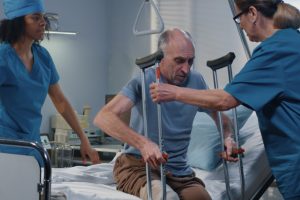 |
 |
|
| Occupation | Nurse Practitioners† | Nursing Assistants | Occupational Therapists |
| Description | Serve as primary and specialty care providers, delivering advanced nursing services to patients and their families. | Provide basic care and help patients with activities of daily living. | Treat injured, ill, or disabled patients through the therapeutic use of everyday activities. |
| Entry-Level Education | Master’s | State-approved education program | Master’s |
| Credentialing Requirements | Varies by state | Varies by state | Licensure required in all states |
| Median Wage ($) | 123,780 | 30,310 | 85,570 |
| Job Outlook, (2021-31) | 46% increase | 5% increase | 14% increase |
| Skills | Communication skills Critical-thinking skills Compassion Detail-oriented Interpersonal skills Leadership skills Resourcefulness |
Communication skills Compassion Patience Physical stamina |
Adaptability Communication skills Compassion Interpersonal skills Patience |
 |
 |
 |
|
| Occupation | Occupational Therapy Aides | Occupational Therapy Assistants | Opticians |
| Description | Perform support activities to help patients develop, recover, and improve. | Provide therapy to help patients develop, recover, and improve. | Help fit eyeglasses and contact lenses and help customers decide which eyeglass frames or contact lenses to buy. |
| Entry-Level Education | High school diploma or equivalent | Associate’s | High school diploma or equivalent |
| Credentialing Requirements | None | Varies by state | Licensure required in most states |
| Median Wage ($) | 33,560 | 61,730 | 37,570 |
| Job Outlook, (2021-31) | 14% increase | 25% increase | 4% increase |
| Skills | Adaptability Compassion Detail-oriented Interpersonal skills Physical strength |
Adaptability Compassion Detail-oriented Interpersonal skills Physical strength |
Business skills Communication skills Customer-service skills Decision-making skills Dexterity |
 |
 |
 |
|
| Occupation | Optometrists | Orthotists and Prosthetists | Pharmacists |
| Description | Examine the eyes and other parts of the visual system. | Design and fabricate medical supportive devices, such as artificial limbs, and measure and fit patients for them. | Dispense prescription medications to patients and offer expertise in the safe use of prescriptions. |
| Entry-Level Education | Doctorate or professional degree | Master’s | Doctorate or professional degree |
| Credentialing Requirements | Licensure required in all states | Varies by state | Licensure required in all states |
| Median Wage ($) | 124,300 | 75,440 | 128,570 |
| Job Outlook, (2021-31) | 10% increase | 17% increase | 2% increase |
| Skills | Decision-making skills Detail-oriented Interpersonal skills Speaking skills |
Communication skills Detail-oriented Patience Physical dexterity Physical stamina Problem-solving skills |
Analytical skills Communication skills Computer skills Detail-oriented Managerial skills |
 |
 |
 |
|
| Occupation | Physical Therapists | Physicians Assistants | Physicians and Surgeons |
| Description | Help injured or ill people improve movement and manage pain. | Examine, diagnose, and treat patients under the supervision of a physician. | Diagnose and treat injuries or illnesses and address health maintenance. |
| Entry-Level Education | Doctorate or professional degree | Master’s | Doctorate or professional degree |
| Credentialing Requirements | Licensure required in all states | Licensure required in all states | Licensure required in all states |
| Median Wage ($) | 95,620 | 121,530 | ≥208,000‡ |
| Job Outlook, (2021-31) | 17% increase | 28% increase | 3% increase‡ |
| Skills | Communication skills Compassion Detail-oriented Dexterity Physical stamina Resourcefulness Time-management skills |
Communication skills Compassion Detail-oriented Emotional stability Interpersonal skills Problem-solving skills |
Communication skills Compassion Detail-oriented Dexterity Leadership skills Organizational skills Patience Physical stamina Problem-solving skills |
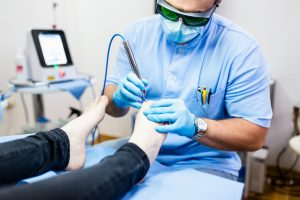 |
 |
 |
|
| Occupation | Podiatrists | Psychiatric Aides | Psychiatric Technicians |
| Description | Diagnose illnesses, treat injuries, and perform surgery for people with foot, ankle, and lower leg problems. | Help patients who have a mental illness or developmental disabilities in their daily activities and ensure a safe and clean environment. | Provide therapeutic care and monitor the conditions of patients with mental illness or developmental disabilities. |
| Entry-Level Education | Doctorate or professional degree | High school diploma or equivalent | Postsecondary nondegree award |
| Credentialing Requirements | Licensure required in all states | None | Licensure required in some states |
| Median Wage ($) | 145,840 | 30,260 | 36,570 |
| Job Outlook, (2021-31) | 2% increase | 5% increase | 11% increase |
| Skills | Communication skills Compassion Critical-thinking skills Detail-oriented Interpersonal skills |
Compassion Interpersonal skills Observational skills Patience Physical stamina |
Compassion Interpersonal skills Observational skills Patience Physical stamina |
 |
 |
 |
|
| Occupation | Psychiatrists | Radiation Therapists | Recreational Therapists |
| Description | Diagnose, treat, and help prevent mental disorders. | Administer doses of radiation to patients who have cancer or other serious diseases. | Plan, direct, and coordinate recreation-based medical treatment programs to help maintain or improve patients’ physical, social, and emotional well-being. |
| Entry-Level Education | Post-doctoral training or doctorate | Associate’s | Bachelor’s |
| Credentialing Requirements | Licensure and certification | Varies by state | Licensure or certification required in some states |
| Median Wage ($) | 226,880 | 82,790 | 47,940 |
| Job Outlook, (2021-31) | 10% | 6% increase | 4% increase |
| Skills | Critical thinking Detail-oriented Integrity Interpersonal communication Listening skills Problem-solving skills |
Compassion Detail-oriented Interpersonal skills Technical skills |
Communication skills Compassion Leadership skills Listening skills Patience Resourcefulness |
 |
 |
 |
|
| Occupation | Registered Nurses | Respiratory Therapists | Speech-Language Pathologists |
| Description | Provide and coordinate patient care, educate patients and the public about various health conditions, and provide advice and emotional support to patients and their families. | Care for patients who have conditions that cause them to have trouble breathing. | Assess and treat people who have speech, language, voice, and fluency disorders. |
| Entry-Level Education | Bachelor’s | Associate’s | Master’s |
| Credentialing Requirements | Licensure required in all states | Licensure required in all states except Alaska | Licensure required in all states |
| Median Wage ($) | 77,600 | 61,830 | 79,060 |
| Job Outlook, (2021-31) | 6% increase | 14% increase | 21% increase |
| Skills | Critical-thinking skills Communication skills Compassion Detail-oriented Emotional stability Organizational skills Physical stamina |
Compassion Detail-oriented Interpersonal skills Patience Problem-solving skills |
Analytical skills Communication skills Compassion Critical-thinking skills Detail-oriented Listening skills |
 |
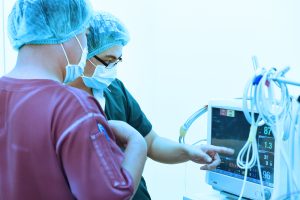 |
||
| Occupation | Surgical Assistants | Surgical Technologists | |
| Description | Help surgeons with tasks such as making incisions, placing clamps, and closing surgical sites. | Prepare operating rooms, arrange equipment, and help doctors and first assistants during surgeries. | |
| Entry-Level Education | Associate’s or postsecondary nondegree award | Associate’s or postsecondary nondegree award | |
| Credentialing Requirements | None; certification may be preferred by employers | None; certification may be preferred by employers | |
| Median Wage ($) | 48,320 | 48,530 | |
| Job Outlook, (2021-31) | 6% increase | 6% increase | |
| Skills | Communication skills Detail-oriented Dexterity Integrity Listening skills Physical stamina Stress-management skills |
Communication skills Detail-oriented Dexterity Integrity Listening skills Physical stamina Stress-management skills |
†Nurse anesthetists, nurse midwives, and nurse practitioners are also known as advanced practice registered nurses (APRNs).
‡The median wage and employment outlook for physicians and surgeons vary by specialty. See the Occupational Handbook for more information.
Other health-related occupations
Note that additional health-related career paths exist, such as those in public health and human services. See the table below for a selection of occupations.
- Over the past 20 years, the healthcare industry has made up a significant proportion of jobs in the U.S. labor force, and that trend is expected to continue through at least 2031.
- Healthcare professionals are expected to possess specific competencies. Engaging in self-reflection is an important step to understanding which competencies (and therefore which career paths) are most suitable to your interests, abilities, and needs.
- Many occupations are available to individuals interested in a healthcare career, including those in the areas of biotechnology research and development, diagnostic services, health informatics, support services, and therapeutic services.
- Competency – the capability to apply or use a set of related knowledge, skills, and abilities required to successfully perform tasks in a defined work setting
- Comptency model – a collection of competencies that define successful performance in a particular work setting
- License – a credential awarded by a governmental licensing agency that gives legal authority to work in an occupation and requires meeting predetermined criteria
- Certification – a credential awarded by a professional organization or other nongovernmental body that is not legally required in order to work in an occupation but demonstrates competency
chapter 3 Test Yourself
Instructions: Select one of the gray boxes below to see if your answer is correct.
References and Attributions
Introduction
“Health Occupations” from MedlinePlus. Published under public domain. Lightly edited for formatting.
Healthcare Careers Background
Healthcare Employment: Past And Future Outlook
U.S. Bureau of Labor Statistics. (n.d.). Employment, hours, and earnings from the Current Employment Statistics survey, seasonally adjusted (National), January 2012 – September 2022 [Data set]. Occupational Employment Statistics. U. S. Department of Labor. Retrieved December 19, 2022, from https://www.bls.gov/ces/data/
The following sources were combined to form the section on the impact of COVID-19 on the healthcare workforce:
- “Impact of the COVID-19 Pandemic on the Hospital and Outpatient Clinician Workforce: Challenges and Policy Responses” from the Office of the Assistant Secretary for Planning and Evaluation, U.S. Department of Health and Human Services. Published under public domain. Lightly edited for brevity, clarity, formatting, and flow.
- “COVID-19 Intensifies Home Care Workforce Challenges” by Denise Tyler, Melissa Hunter, Natalie Mulmule, and Kristie Porter. Published by the Office of the Assistant Secretary for Planning and Evaluation, U.S. Department of Health and Human Services under public domain. Lightly edited for brevity, clarity, formatting, and flow.
“Healthcare Occupations” from the U.S. Bureau of Labor Statistics. Published under public domain.
Core Skills in Healthcare
“Competency Model Development And Use – A Technical Assistance Guide” and “Fundamentals of Health Care Competency Model” from the Competency Model Clearinghouse, a website sponsored by the U.S. Department of Labor, Employment and Training Administration (USDOL, ETA). Published under a CC BY 4.0 license. Lightly edited for brevity, clarity, and flow. USDOL, ETA has not approved, endorsed, or tested these modifications.
Choosing a Career
“Your Map to Success: The Career Planning Cycle” in College Success by Amy Baldwin. Published by OpenStax under a CC BY 4.0 license. Lightly edited for brevity and consistency with its new context. Access for free at https://openstax.org/books/college-success/pages/1-introduction
Other Factors
The following sources were combined:
- “Career Exploration – College Success” in College Success. Published by the Center for Open Education under a CC BY-NC-SA 4.0 license. Lightly edited for brevity and formatting.
- “Browse by Work Context” by the National Center for O*NET Development. Published under a CC BY 4.0 license. Content was significantly edited for formatting and consistency with its new context.
“Will I need a license or certification for my job?” by Elka Torpey. Published by the U.S. Bureau of Labor Statistics under a public domain license. Lightly for flow.
“FAQs [What is accreditation?]” by the Database of Accredited Postsecondary Institutions and Programs. Published by the U.S. Department of Education, Recognition and Accreditation under a public domain license. Lightly edited for consistency with its new context.
Occupational Profiles
“29-1223.00 – Psychiatrists” by the U.S. Department of Labor, Employment and Training Administration (USDOL/ETA). Published under a CC BY 4.0 license.
Occupational descriptions and data from the Occupational Outlook Handbook except where noted. Published by the U.S. Bureau of Labor under a public domain license. Lightly edited for brevity and flow.
Image Descriptions
Figure 3.1: Line graph comparing employment trends. The X-axis represents one-year increments, beginning in 2013 and ending in 2022. The left y-axis represents total nonfarm employment in 5,000 increments, beginning at 125,000 and ending at 155,000. The right y-axis represents healthcare and related employment in 5,000 increments, beginning at 14,500 and ending at 18,500. The graph shows steady growth in both nonfarm and healthcare and related employment between 2012 and 2020. Both lines have a steep decrease in 2020. The graph ends with both lines increasing in 2022 to pre-2020 numbers. [Return to Figure 3.1].
Image 3.1: A Venn diagram showing the relationship between “You” and “Career Fitness.” In the left circle, the “You” attributes are interests skills/aptitudes, values, and personality. Your strengths include your knowledge, skills, and abilities. In the right circle are the characteristics of a job: duties, qualifications, expectations and standards, working conditions, and career path. The employer’s needs include knowledge, skills, and abilities. Where the two circles intersect is text that reads “Employer Needs + Your Strengths = Fit”. [Return to Image 3.1].






